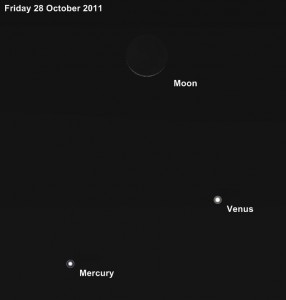These notes are intended to provide a casual sky watcher or someone already into amateur astronomy living on the East Coast of Australia with a short summary of what is happening in the night sky in October 2011. Instructions on how to obtain customised satellite viewing information for your location can be found here. If you find this page of interest, you may wish to follow this website automatically using Twitter and the sites RSS Feed.
Note that all times are listed in the AEST time zone (U.T. plus 10 hours). Add one hour to times listed if your state or territory follows daylight savings time.
Planets this month (October 2011)
If you are just starting out in astronomy, you might be interested in knowing that the word ‘planet’ comes from an ancient Greek word that means wanderer. Early astronomers knew that there were five wandering stars visible in the sky at various times but they were not aware that they were other worlds. Planets further from the Sun than Jupiter (this includes Uranus and Neptune) are not visible to the unaided eye and had to await the invention of the telescope before they were discovered.
Mercury is visible low above the Western horizon from just before the middle of October in the evening twilight. By the end of October, Mercury will be close to brilliant Venus as evening twilight ends.
Venus is visible in the evening twilight sky this entire month low on the Western horizon.
Mars is visible in the morning sky from around 2 am AEST mid-month. Look above the Eastern horizon.
Jupiter rises around 7 pm AEST mid-month.
Saturn is in conjunction with the Sun on 14 October. Saturn will return to Earth’s morning sky next month.
Uranus and Neptune are both above the Eastern horizon before the sun sets. Both require a finder chart to locate them with either a (large) pair of binoculars or a telescope. A finder chart can be downloaded from http://www.skyandtelescope.com/observing/objects/planets/12435011.html
The minor planet Vesta is ideally placed for locating using either a (large) pair of binoculars or a telescope. A finder chart can be downloaded from http://www.skyandtelescope.com/observing/objects/asteroids/122249184.html
Individual Sky Events (October 2011)
October 2: Mars located just below the centre of M44 (the Beehive Cluster) in the ancient Greek constellation Cancer ‘The Crab’. From dark sky locations, M44 is easily visible to the unaided eye as a fuzzy patch in the night sky. Mars will appear as a slightly orange coloured star to the unaided eye.
October 4: 1.15 pm First Quarter Moon
October 5: Minor planet Vesta will be located 0.05 degees South of the 4th magnitude star Psi Capricornus. This will make it easy to find if you are unfamiliar with the night sky. While a 4th magnitude star isn’t particularly bright, it is much brighter that Vesta will be (at magnitude 6.3 it is at the edge of what is visible to the unaided eye under dark sky conditions).
October 11: Mercury at descending node.
October 12: 12.06 pm AEST Full Moon
October 12: 10 pm Moon at apogee (furthest from the Earth in its orbit at 406,434 km).
October 13: The Moon will be located to the left of Jupiter in the late evening sky (look low above the Eastern horizon).
October 14: 7 am Saturn in conjunction with the Sun
October 20: 1.30 pm Last Quarter Moon
October 22: Mercury at aphelion
October 22: Orionid meteor shower peaks. Unfortunately light from the Moon (located in the morning sky) will flood the morning sky making all but the brightest meteors invisible to the eye.
October 22: Crescent Moon is located above Mars in the morning sky. Look low above the Eastern horizon.
October 26: 10 pm Moon at perigee (closest to Earth in its orbit at 357,052 km)
October 26: Venus at descending node
October 27: 5.56 am New Moon
October 28: 12.00pm (Noon) Daytime occultation of Mercury by the Moon. The exact disappearance and reappearance times will vary depending on where you are located in Australia. This event should be visible in a medium sized telescope. Take care however as both the crescent Moon and Mercury will be located close to the Sun.
October 28: Mercury, Venus and a slim crescent Moon will appear together as a temporary triangle low above the Western horizon as evening twilight ends.
- Mercury, Venus and crescent Moon finder chart for 28 October 2011.
October 29: Jupiter is at opposition. This means that Jupiter will rise as the Sun sets, and then set as the Sun rises the following morning. Opposition is also generally the time when a planet is at its closest in its orbit to the Earth. This makes it the best time to observe Jupiter. Jupiter will reach magnitude – 2.9 (thanks to a quirk of history, the more negative the number the brighter the object will appear).
For Further Information
Planet and Moon Rise/Set Times
Planet and Moon rise/set times for 2011 can be found here on this website.
Customised Astronomy & Satellite Viewing information
Information on how to obtain customised astronomy & satellite viewing information for your location can be found here on this website.
